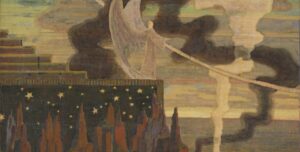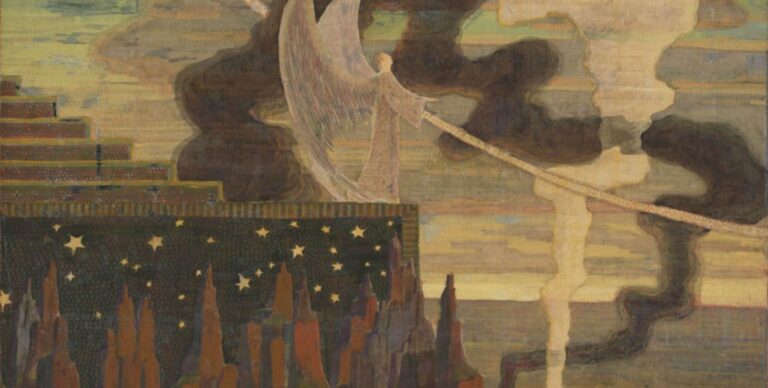The Museo Diocesano in Milan sets up one of these exhibitions each year around Christmas and Easter: they feature a singular work from a major artist, and dive deep into the understanding of this work, often pairing it with the interpretation of contemporary artists. Last year, I talked about Beato Angelico‘s Childhood of Christ, and Bellini‘s Lamentation was the work featured last Easter. This year is the turn of Tintoretto‘s masterpiece Christ’s Deposition, a work from the Venetian Renaissance on loan from the Gallerie dell’Accademia in Venice.
Originally created around 1562 for the Church of Santa Maria dell’Umiltà alle Zattere, the painting is renowned for its dramatic composition, dynamic use of light and shadow, and emotional depth, with the body of Christ being carried on one side and the Virgin Mary fainting with grief on the other side.
In a contemporary dialogue with Tintoretto’s work, four modern artists—Jacopo Benassi, Luca Bertolo, Alberto Gianfreda, and Maria Elisabetta Novello—offer their interpretations through various media, including installation and painting. This initiative, in collaboration with Casa Testori, invites visitors to explore the interplay between historical and modern artistic expressions.
Luca Bertolo
Luca Bertolo, born in 1968 in Milan, is a painter recognised for his conceptual and experimental approach. Initially trained in computer science at the University of Milan, he later pursued painting at the Accademia di Belle Arti di Brera, graduating in 1998. His career has included residencies in São Paulo, London, Berlin, and Vienna, and he currently resides and works in Seravezza, Tuscany.
Bertolo’s artistic practice is characterised by a deep engagement with the medium of painting itself. He often explores the tension between abstraction and figuration, which I always enjoy. He frequently employs the motif of the stain as a fundamental element, using it to both obscure and reveal forms within his compositions.
His contribution at the Museo Diocesano, Veronica #1 (2024), is an oil and acrylic painting on sewn canvases that engages with the themes of suffering and redemption present in Tintoretto’s masterpiece and refers to the figure of Saint Veronica, the woman who – as the story goes – dried Christ’s face from sweat and blood with a cloth during his climb to Golgotha and his face miraculously stayed imprinted in the canvas. The actual relic is called the Veil of Veronica (Sudarium Veronicae), still venerated though being scientifically proven as a fake.
If you’re not easily impressed by religion and mysticism (and after 15 years with the nuns, I can say I am not), the show’s kick off is a bold choice: this piece is all about what’s not there. In Luca Bertolo’s take on the famous “Veil of Veronica,” the veil shows no face at all. Light, creamy canvas. But not empty at all: this “total canvas” hits you with a sense of something missing, something waiting to be revealed. It’s deep, it’s textured, it’s got layers (literally and metaphorically).
Bertolo’s approach is never loud, but deeply thoughtful. He crafted his “Veronica” on a patchwork of discarded canvas scraps—bits and pieces from failed paintings, repurposed. The result is a beautiful Frankenstein of painterly effort, stitching together the story of hard work, failed ideas, and the daily grind of art-making. The veil painted on top of it becomes a metaphor, not just for the divine, but for the artist’s own journey: messy, stitched-together, unresolved, but deeply personal. It’s like if your emotional baggage became a painting—and somehow, it’s stunning.
Because honestly, what better way to talk about Passover than through something that wears its scars proudly?
Jacopo Benassi
Jacopo Benassi, born in 1970 in La Spezia, is a photographer and multidisciplinary artist who, as far as I understand it, emerged from the underground music scene in the 1980s, His distinctive style in photography is characterized by the use of direct flash and the deliberate elimination of depth of field, resulting in stark, unfiltered photographs that confront the viewer with their immediacy, but his work spans various media, including performance, painting, and installation. His subjects range from portraits of artists and designers to explorations of the human body and self-portraiture. He has exhibited internationally at institutions such as the Tate Modern in London and the Palais de Tokyo in Paris.
Flashback to 1988: 18-year-old Jacopo Benassi, full of artistic drive, paints a copy of Caravaggio’s Entombment of Christ. His mother Giusy loves it and claims it for her bedroom wall. And there it stayed—faithfully hanging there from 1989 all the way until 2022, when she passed away.
That moment sparked something deep for the artist. When he took the painting down, he noticed it had left a mark on the wall—like a quiet ghost of the artwork, still lingering. It was as if Giusy had never let it go. That trace became the first thing he photographed, a tender nod to his mother’s connection with the piece and his own journey from painter to photographer over three decades.
Benassi didn’t stop there. He added another photo: a raw, honest image of a table piled with the telltale signs of his mom’s daily life—her ashtray, her cigarettes. Then he framed both the painting and the photos together, strapping them into one powerful mixed-media bundle. The result? A deeply personal narrative that’s half memorial, half love letter.
And here’s a cool twist: the only part of the original Caravaggio visible is Christ’s arm—falling, lifeless. It mirrors the drama of Tintoretto’s Descent from the Cross, tying art history into this very human story. Oh, and that year painted on the wall? 1943. His mother’s birthyear.
To round it all off, Benassi added a final touch: a sculptural lamp he built himself. It’s part light, part art, part work-in-progress pause button—crafted from modeling clay and turned off as if taking a coffee break from the creative grind. That lamp doesn’t just illuminate the piece; it sheds light on the artist’s own emotional construction site, where art and memory are still very much under renovation.
Alberto Gianfreda
Alberto Gianfreda (b. 1981, Desio) is a sculptor renowned for his exploration of themes such as resilience, identity, and the transformative power of matter. Educated at the Accademia di Belle Arti di Brera in Milan, where he currently teaches sculpture techniques, Gianfreda further specialised in Sacred Art and Anthropology and completed his training at the TAM centre under the direction of Nunzio Di Stefano.
His contribution at the Museo Diocesano is called Materia comune (2025), and it’s a stunning installation composed of white ceramic plates, an aluminium chain, and stools shaped in the general form of Christ’s body as he’s being deposed from the Cross, reflecting on fragmentation, reconstruction, and the interplay between memory and material. Gianfreda’s approach emphasises the instability of form and the process of reassembling broken elements; through his use of everyday materials and modular assemblages, he invites to contemplate the transient nature of form and the mystery of a seemingly impossible rebirth. Though I’m not religious, I’ve rarely seen a depiction of the resurrection that’s more on point.
Maria Elisabetta Novello
Maria Elisabetta Novello (born 1974, Vicenza) works on similar themes, as her practice in visual arts often centres on ephemeral materials—primarily ash and dust—as metaphors for memory, impermanence, and the fragility of existence. A graduate of the Accademia di Belle Arti di Venezia, she has developed a poetic language that intertwines personal and collective histories through subtle, minimal gestures and works in the form of installations and landscapes, where the material itself becomes a vessel for transformation and reflection.
I had the chance of viewing her work in association with an installation by Jannis Kounellis, a work where heavy and yet delicate glass blocks were balancing on steel scales.
Her contribution in this exhibition is a little more didascalic, with ash and dust, quoting the final, haunting verse of Il canto delle crisalidi, a poem by Carlo Michelstaedter, a brilliant young thinker from Gorizia who passed away way too soon, at just 23. He wrote about what he called the “tragedy of finiteness”—and that theme struck a chord with the artist. Friuli, Michelstaedter’s homeland, feels like a second home to her. She’s carried that emotional thread into her work, finding in Tintoretto’s paintings the same powerful tension between life and death that Michelstaedter wrote about. This isn’t just about death, though—it’s about the tender, inevitable truth that everything is finite, fleeting, and therefore, incredibly precious.










1 Comment
Pingback:A Photo Journey to the Ends of the Earth – Shelidon
Posted at 21:45h, 18 April[…] the ground floor of Museo Diocesano, downstairs from Tintoretto’s Deposition, photographer Alessandro Grassani takes us on a visual journey titled Emergenza Climatica – Un […]